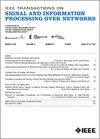A Nonconvex Low Rank and Sparse Constrained Multiview Subspace Clustering via $l_{\frac{1}{2}}$-Induced Tensor Nuclear Norm
IF 3
3区 计算机科学
Q2 ENGINEERING, ELECTRICAL & ELECTRONIC
IEEE Transactions on Signal and Information Processing over Networks
Pub Date : 2023-08-17
DOI:10.1109/TSIPN.2023.3306098
引用次数: 0
Abstract
In the realm of clustering of multi-view data, many of the clustering methods, generate view-specific representations for individual views and conjoin them for final grouping. However, in most of the cases,such methods fail to effectively discover the underlying complementary information and higher order correlations present in a multi-view data. Unlike many of the existing works, this paper proposes a nonconvex low rank tensor approximation based clustering framework for multi-view data, relying on the self-expressiveness property of free submodules. Instead of creating individual representation for each view, the proposed method creates a single optimal representation tensor for all the submodules, with a low tensor rank and an f-diagonal structure. The基于$l_{\frac{1}{2}}$诱导张量核范数的非凸低秩稀疏约束多视图子空间聚类
在多视图数据的聚类领域中,许多聚类方法为各个视图生成特定于视图的表示,并将它们结合起来进行最终分组。然而,在大多数情况下,这种方法无法有效地发现多视图数据中存在的潜在互补信息和高阶相关性。与现有的许多工作不同,本文基于自由子模块的自表达性,提出了一种基于非凸低秩张量近似的多视图数据聚类框架。所提出的方法不是为每个视图创建单独的表示,而是为所有子模块创建一个具有低张量秩和f对角结构的最优表示张量。$l_{\frac{1}{2}}$诱导的张量核范数(TNN)作为低张量秩约束引入,改善了表示张量的低秩性。此外,通过具有$l_{\frac{1}{2}}$正则化的相异矩阵,将结构约束集成到所提出的方法中。此外,所提出的相异性矩阵能够更有效地提取每个横向切片下的互补信息和高阶相关性。在几个具有挑战性的多视图数据集上,使用流行的评估措施评估了所提出方法的聚类效率。将所提出的方法的实验结果与最先进的单视图和多视图聚类方法进行了比较。对比结果表明,与现有的聚类方法相比,该方法的性能有所提高。
本文章由计算机程序翻译,如有差异,请以英文原文为准。
求助全文
约1分钟内获得全文
求助全文
来源期刊

IEEE Transactions on Signal and Information Processing over Networks
Computer Science-Computer Networks and Communications
CiteScore
5.80
自引率
12.50%
发文量
56
期刊介绍:
The IEEE Transactions on Signal and Information Processing over Networks publishes high-quality papers that extend the classical notions of processing of signals defined over vector spaces (e.g. time and space) to processing of signals and information (data) defined over networks, potentially dynamically varying. In signal processing over networks, the topology of the network may define structural relationships in the data, or may constrain processing of the data. Topics include distributed algorithms for filtering, detection, estimation, adaptation and learning, model selection, data fusion, and diffusion or evolution of information over such networks, and applications of distributed signal processing.
 求助内容:
求助内容: 应助结果提醒方式:
应助结果提醒方式:


